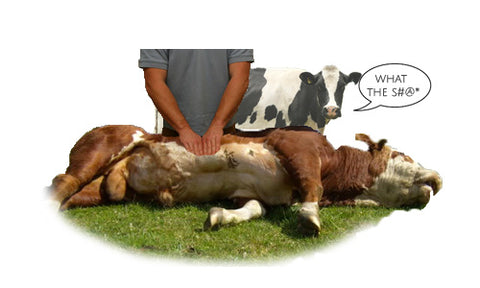Psoas Conundrum

Mmmmmmm steak! Recently my wife and I made the family menu transition to Pescaterian. That one step above vegetarian that allows you to keep some type of meat in your diet…fish. Now, while I really like salmon, there is something that just doesn’t satisfy like a good, thick, Psoas Major with béarnaise sauce dripping from the slightly crusted surface. Yep. That’s right. Psoas Major. In a cow, Psoas is the largest, thickest portion of what is termed tenderloin. In humans, Psoas Major is a fusiform muscle of approximately 16 inches in the adult.
It has a superficial and deep layer; the former arises from the transverse processes of L3-5 and the brim of the lesser pelvis. The superficial layer arises from the lateral surface of the lower thoracic and all lumbar vertebrae plus their associated discs. These two muscle layers traverse downward and laterally under the inguinal ligament and over the iliac fossa to become continuous with the iIiacus muscle. In humans, the psoas is a combination of fast and slow twitch fibers. Regarding Psoas minor, this exists in only 50% of humans. It is a long slender skeletal muscle running anterior to the medial border of psoas major and is a weak flexor of the hip. Psoas minor arises from the facets of T12-L1 and inserts into the iliopectineal eminence. Fibers also stretch and attach to the deep iliac fossa with fibers to the inguinal ligament. The remaining portion of the group is combined with Iliacus. This flat wide muscle fans from the borders of the iliac fossa downward to blend with fibers of the psoas muscle(s) before attaching to the lesser trochanter.
As Psoas histologically has a combination mix of fast and slow twitch fibers, Psoas muscle (PM) function with regard to the lumbar spine (LS) is disputed. Electromyographic studies attribute to the PM a possible role as stabilizer. Anatomical textbooks describe the PM as an LS flexor, but not a stabilizer. According to more recent anatomical studies, the PM does not act on the LS, because it tends to pull the LS into more lordosis by simultaneously flexing the lower and extending the upper region, but due to the short moment arms of its fascicles, this would require maximal muscular effort and would expose the LS motion segments to dangerous compression and shear. These findings would indicate that the described opposite action of the PM on upper and lower LS regions, performed passively and requiring minimal muscular effort, may serve to stabilize the LS in an upright stance. It has been demonstrated that a vertically placed elastic metal strip, modelled into a lordotic configuration to imitate the LS, will be brought into more lordosis, with maintenance of vertical position, if a string fastened at its upper end is pulled downward in a very specific direction. Conversely, any increase of lordosis of the strip brought about by vertical downward pushing of its top, will be stabilized by tightening the pulling string in the same specific direction. As this direction corresponded with the psoas orientation, the experiments show that the PM probably functions as a stabilizer of the lordotic LS in an upright stance by adapting the state of contraction of each of its fascicles to the momentary degree of lordosis imposed by factors outside the LS, such as general posture, general muscle activity and weight bearing. The presence of multiple PM fascicles, all of about equal length, and attaching to all LS levels, facilitates this function.Some researchers and anatomists still refer to the hip flexor muscle complex as one unit or as the iliopsoas. The psoas muscle differs from the iliacus in that it has a different architecture, innervation and more importantly, a different function. A better understanding of the role of the psoas muscle and its impact on lumbopelvic stability may improve the clinical management of individuals suffering from lower back pain. So with understanding that Psoas might be more apt to be viewed as a stabilizer vs. a mover, then why are we stretching Psoas or performing soft tissue mobilization (espcially since this is ridiculously painful for the client and likely just compresses that large piece of tendeloin that I just put into my small intestine about 2 hours ago)? And trying to get a muscle to stretch by combining hip extension with lumber flexion is close to impossbile considering that according to Park and Hodges in a 2013 study that Recruitment of discrete regions of the psoas major and quadratus lumborum muscles is changed in specific sitting postures in individuals with recurrent low back pain. They found that in individuals with LBP, that Psoas was tonic enough to have a potential extensor moment, even in sitting. So if sitting can’t shut off Psoas Major in our clients, then how do we expect to stretch against that force in any other position?
Nachemson showed that the psoas major was active during upright standing, forward bending, and lifting. These observations prompted the inference that the psoas major may function as a lumbar spine stabilizer. Others have since proposed and found evidence for various roles that the psoas major may play with respect to lumbar spine stability and movement. These roles include psoas major being a flexor of the lumbar spine on the pelvis, a lateral flexor of the lumbar spine, a stabilizer of the lumbar spine, stabilizer of the hip, power source for bipedal walking and running, and controller of the lumbar lordosis when supporting difficult lumbar load.
Yoshio et al. used cadavers to analyze the psoas major in its dynamic phase (as a flexor of the hip joint) as well as in its static phase (involving fixation of the hip joint to maintain a sitting or standing position against gravity). Their results suggest that the psoas major works phasically: as an erector of the lumbar vertebral column, as well as a stabilizer of the femoral head onto the acetabulum (from 0°–15°); exerting decreased stabilizing action, in contrast to maintaining the erector action (from 15°–45°); and as an effective flexor of the lower extremity at the hip joint (from 45°–60°). They further concluded that the function of the psoas major as a hip stabilizer is overshadowed by its action of stabilizing/erecting the lumbar vertebral column.
The electromyographic work of Basmajian was the first to investigate the role of the iliopsoas. He concluded that the psoas major could not be separated from the iliacus with regards to their collective action of a hip joint flexor. Keagy et al.performed electromyographic studies on the psoas major in five patients with wire electrodes placed directly into the muscle. Recordings made during various activities indicated that psoas played a significant role in advancing the limb while walking and in controlling deviation of the trunk when sitting. The action of the psoas in rotation, abduction, and adduction of the hip was slight and variable.
Over the last decade, new insights into muscle function and the role of muscles in providing dynamic stability have emerged. Some muscles may have stabilization of the lumbosacral spine as their primary role, while others appear to have multiple roles and these multiple roles may be dependent upon spinal position and the loads being transmitted to the spine (i.e. low load vs. high load).
Recent research on lumbar musculature and how it relates to individuals suffering from lower back pain has progressed through the use of advanced imaging techniques. Dangeria and Naesh conducted a clinical prospective cohort study examining the cross-sectional area of the psoas major in healthy volunteers and subjects with unilateral sciatica caused by a disc herniation. These authors demonstrated that in most patients with a lumbar disc herniation there was a significant reduction in the cross-sectional area of the psoas major on the affected side only and most prominently at the level of the disc herniation. They suggested that a correlation exists between the reduction in the cross-sectional area of the psoas major (Spearmann’s rho = 0.8; P = 0.05) and the duration of continuous sciatica of the affected side but that no correlation exists between the amount of disc herniation and reduction in psoas major cross-sectional area. Similarly, Danneels et al. examined the trunk muscles (paraspinal, psoas and multifidus) in chronic low back pain patients and healthy control subjects employing computerized tomography at three different lumbar levels. These authors found no significant differences in the cross-sectional area of the psoas major or paraspinals but they did find significant differences existed in the cross-sectional area of the multifidus at the L4 spinal level. Barker et al. investigated the cross-sectional of the psoas major in the presence of unilateral low back pain through the utilization of magnetic resonance imaging (MRI). These authors found that there were statistically significant differences in cross-sectional area of the psoas major between sides (median reduction was 12.3%) at the levels of L1–L5 and that there was a positive correlation between a decreased cross-sectional area of the psoas major and the duration of symptoms.
SOMETHING TO PONDER:
Now going back to dinner, consider the souce of what is on your plate with what we just reviewed. What type of demands are fucntional for our bovine commodities? Stability? Or fast twtich movement? Perhaps, as in other parts of the body, like Gastrocnemeus, Psoas Major ends up being a product of it’s environmental demands? Does the high level athlete dictate a different function our of psoas than the standard poplulation? In 2009, Arbanas found that psoas had a predominance of type IIA muscle fibres, whereas type I muscle fibres had the largest cross-sectional area. Type IIX muscle fibres were present as a far smaller percentage and had the smallest cross-sectional area. Moreover, the fibre type composition of the psoas major muscle was different between levels of its origin starting from the first lumbar to the fourth lumbar vertebra. They concluded that the fibre type composition of the psoas major muscle indicated its dynamic and postural functions, which supports the fact that it is the main flexor of the hip joint (dynamic function) and stabilizer of the lumbar spine, sacroiliac and hip joints (postural function). The cranial part of the psoas major muscle has a primarily postural role, whereas the caudal part of the muscle has a dynamic role. A common model of lumbar stability shows the musculature surrounding the spinal vertebrae forming a capsule. The top of the capsule is the diaphragm, the bottom is the pelvic floor, and the wall is formed by segmentally attaching abdominal and posterior spinal musculature, specifically the transversus abdominus and the segmental fibers of lumbar multifidus. What we have reviewed is that there is growing evidence that demonstrates how these muscles coordinate their activity to stabilize the spine. For example, transversus abdominis has been shown to co-contract with: the diaphragm; the pelvic floor; and the deep fibres of lumbar multifidus. According to this model, the psoas major is ideally located to assist in a stabilizing role. Psoas major has intimate anatomical attachments to the diaphragm and the pelvic floor. This unique anatomical location allows the psoas major to act as a link between these structures and may help in maintaining the stability of the lumbar cylinder mechanism. More focus might be spent on challenging “why” the Psoas Major is tonic to protect in the first place. Facet restrictions, changes in the SIJ, strong muscle imbalance imposing a force on the lumbar segments, sustained postures, and anatomical changes might all contribute to having the Psoas sense a “threat” to this area and act to protect what it doesn’t understand. Not wanting to get too much into the current pain science movement during this blog, I will leave that…at that.
Eric M. Dinkins, PT, MS, OCS, Cert. MT, MCTA


Leave a comment
Please note, comments must be approved before they are published